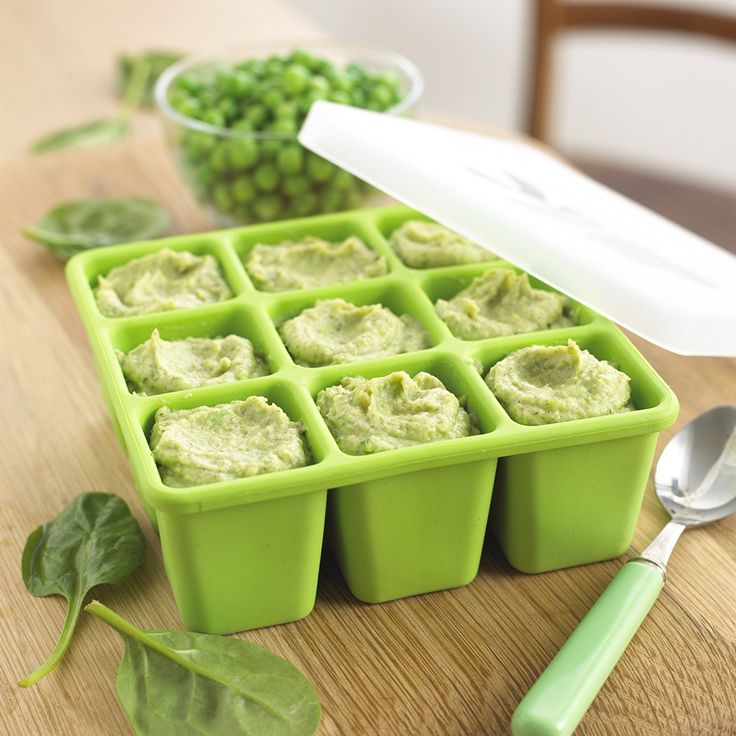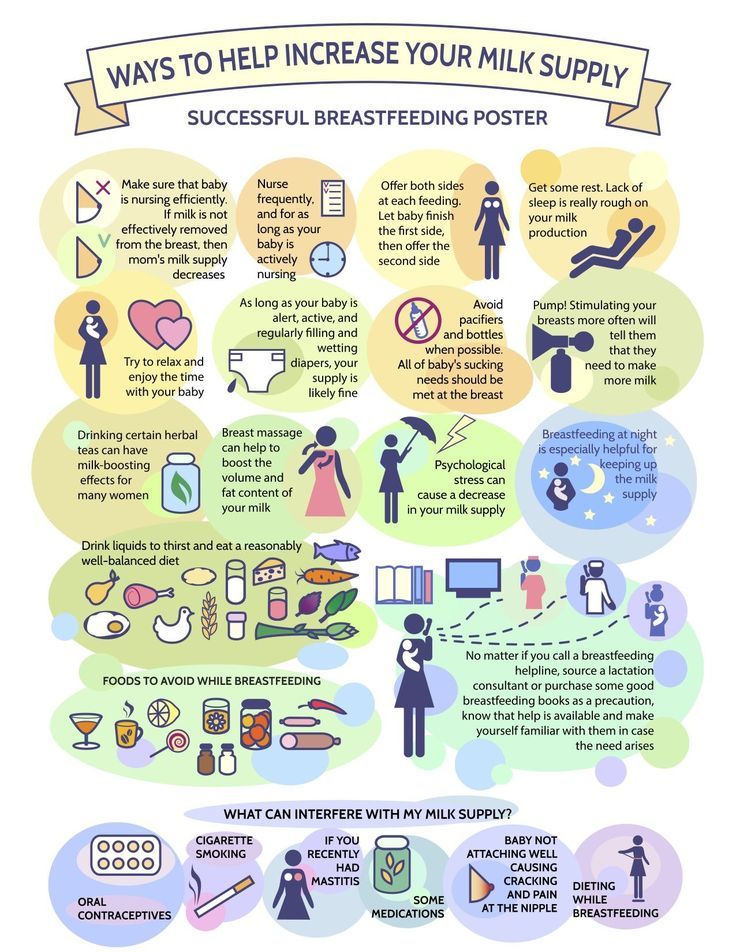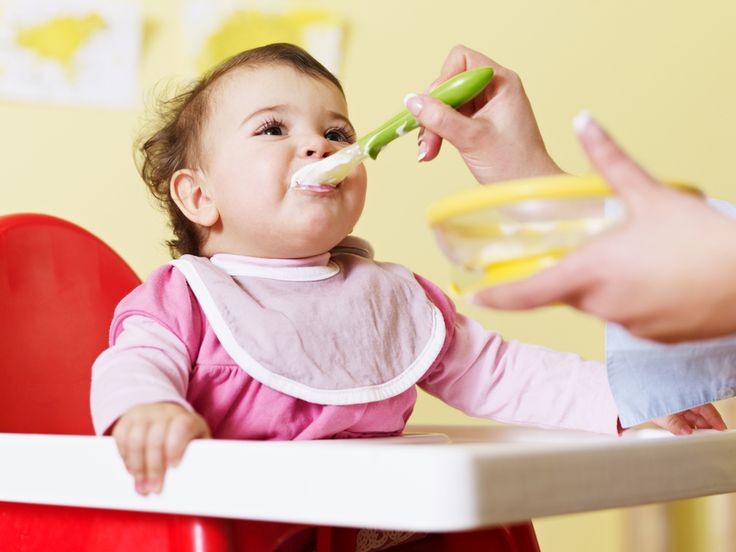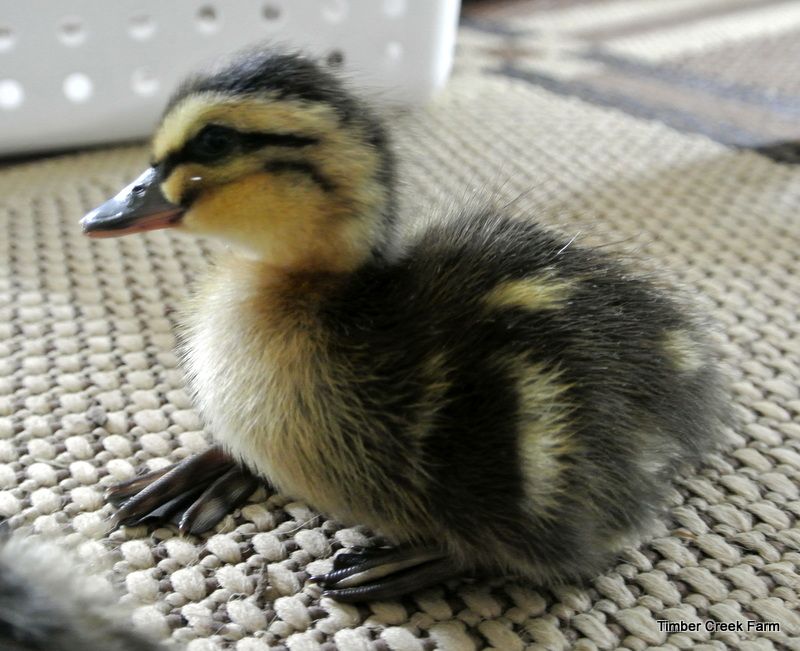When to stop baby food in jars
When to wean your toddler (and yourself) off baby food, and other meal tips for kids
Customize Your Weather
Set Your Location:
Enter City and State or Zip Code
Pureed foods are well and good, but by baby's first birthday, he should be getting plenty of finger foods.A Portland father of a toddler asks: “When (if ever) do I need to lay off the baby food? She eats a fair amount of big-people food, but sometimes baby food is just too easy and convenient.”
Marta Vaughn, a pediatric clinical dietitian at
The Children's Hospital at Legacy Emanuel
, replies that by age 2, a generally healthy, typically developing child should “be ready to consume most of the same foods offered to the rest of the family, with some extra preparation to prevent choking.”
Nutritionally speaking, Vaughn says, jarred baby foods and whole foods are equal. And, she says, some parents have told her that they stick with jarred foods because those are the only vegetables their child will eat.
That’s understandable, Vaughn says, “but we would rather have the child moving toward eating whole foods.” Here’s why:
- Eating only pureed foods “doesn’t help the child to learn to adapt to a new texture or a new trait,” Vaughn says.
- Pureed baby foods “are pretty mundane,” which for some kids can translate into boredom with eating; other children may have the opposite reaction, clinging to baby foods as the only diet they’ll accept.
- “Pureed foods are usually being fed by a parent, so the parent’s continually pushing it on the kid,” which can override a child’s natural sense of appetite regulation, Vaughn says. With finger foods, the child has more control over how much she’s eating. That ability to know when she’s had enough is “so important for kids to hang onto as they grow into adolescence and adulthood,” Vaughn says.
To help your child transition from baby foods to table foods, Vaughn offers these tips:
Offer finger foods starting around age 1.
“I think a lot of families are very afraid of their child choking,” Vaughn says, “but if it’s soft and a long, broad shape, not circular, a food is not likely to cause a choking hazard.”
Honey, I shrunk the food.
Look for ways to make a meal finger-friendly. Say you’re having pizza — cut it up into little squares that a toddler can pick up and chew. Or, if you’re serving something like minestrone and bread, the beans, potatoes and carrots could all be pulled out of the soup and placed on the child’s tray or plate for her to practice finger-feeding, Vaughn says. The bread can be sliced into strips.
As children grow accustomed to eating table foods, Vaughn says, parents should keep these strategies in mind for proper nutrition:
Set a good example.
“I have some parents who are really gung-ho on getting their children to eat healthy, but the parents themselves haven’t really adopted that rule,” Vaughn says. “If you want your child to be eating fruits and veggies, they also need to be included in your meal.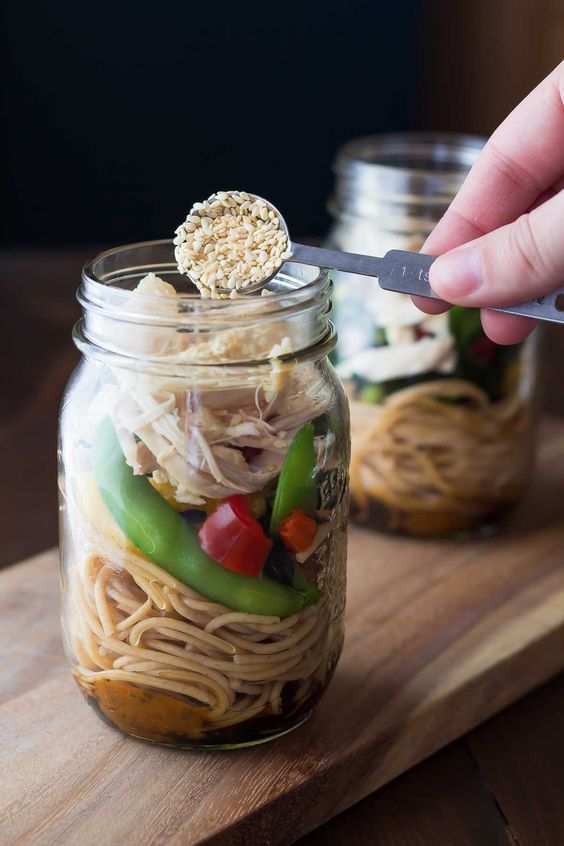 ”
”
Don't be a short-order cook.
“I tell families to serve everyone the same meal and be open-minded about what they expect their kids to eat,” Vaughn says. If children don’t respond positively to all parts of a meal, that’s OK: “A finished meal doesn’t necessarily have to be the requirement for a child to be well nourished,” Vaughn says. What’s more important, she says, is repeated exposure to different foods.
Let children serve themselves.
Vaughn says she had one client who was overweight because she enjoyed eating and her parents always served her adult-size portions. Many children, when allowed to serve themselves, will choose more age-appropriate portions. Of course, they may take fewer vegetables, too; in that case, Vaughn says, tell your child that he must take a vegetable and try it, but he doesn’t have to eat all of it. And look for the teachable moment: If Junior takes two scoops of macaroni and cheese and then doesn't finish his meal, remind him of his natural appetite that the next time you serve mac and cheese.
--
Amy Wang
If you purchase a product or register for an account through one of the links on our site, we may receive compensation.
When Do Babies Stop Jar Food?
Babies' first solid foods often come from a jar, and they may continue to eat jarred food for several months or longer. A variety of food is available in jars for babies, from finely pureed fruits and vegetables for babies just starting solids to chunky stews and finger foods for toddlers. When you stop buying food in a jar is really up to you, but some guidelines can help you decide.
Benefits of Jarred Food
Baby food in a jar is convenient; you can keep a few jars in your diaper bag so your baby always has a meal ready. When babies are young they need to eat frequently, so it's nice to have a small stock of healthful foods on hand wherever you go. Baby food in a jar comes in small portions, just right for a baby. You don't have to worry about making too much of something and having it go bad. Because it's in sealed jars, baby food doesn't have to be refrigerated before it's open, so you can store it in a cabinet.
Because it's in sealed jars, baby food doesn't have to be refrigerated before it's open, so you can store it in a cabinet.
- Baby food in a jar is convenient; you can keep a few jars in your diaper bag so your baby always has a meal ready.
- When babies are young they need to eat frequently, so it's nice to have a small stock of healthful foods on hand wherever you go.
Learning to Eat
4-Month-Baby Diet
Learn More
When babies are first starting solids, they have to learn how to eat from a spoon. For the first 4 to 6 months, baby has only had to suck to receive her food. Now she has to move her mouth in a whole new way. Babies can't chew food when they're first starting solids, either, so they need food that's very soft, nearly liquid. As your baby gets older, more teeth come in, and she perfects the art of swallowing from a spoon. Then you can start giving her food with a little more texture and start incorporating soft finger foods.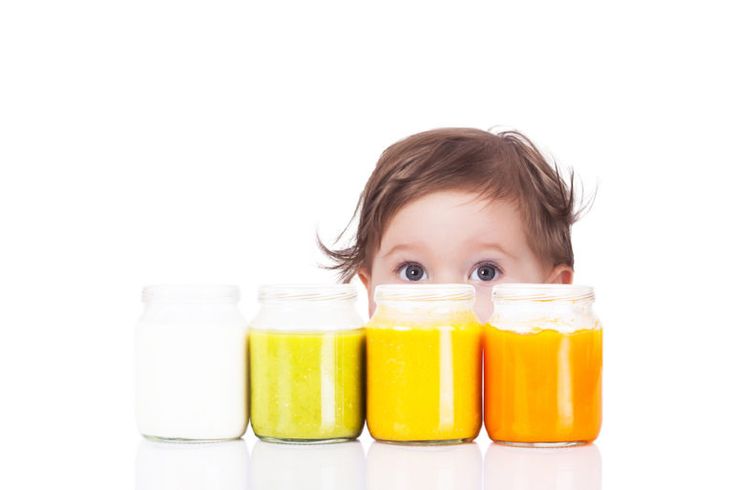 You can buy food in jars for older babies and toddlers, or you can start giving her portions of what you're eating.
You can buy food in jars for older babies and toddlers, or you can start giving her portions of what you're eating.
- When babies are first starting solids, they have to learn how to eat from a spoon.
- Babies can't chew food when they're first starting solids, either, so they need food that's very soft, nearly liquid.
Feeding Safety
Even though your baby at 1 year old can eat most of what you can eat, he can still choke if his food is too hard or the pieces are too large. Jarred baby food is soft and easy to chew, and the pieces are very small. If you want to get away from the jar food, make sure you cook all your baby's food until it's soft or give him things that are naturally soft, like bananas. Cut his food into very small chunks to reduce the risk of choking.
- Even though your baby at 1 year old can eat most of what you can eat, he can still choke if his food is too hard or the pieces are too large.

- If you want to get away from the jar food, make sure you cook all your baby's food until it's soft or give him things that are naturally soft, like bananas.
Transitioning from Jar to Table
Can 4-Month-Old Babies Eat Brown Rice?
Learn More
Around 8 months, your baby is probably ready to start eating food with more texture. She no longer needs all her food to be pureed, so you can start feeding her from the table. Offer soft foods such as soft cheeses, cooked chunks of apple and carrot, and O-shaped cereal to help her develop her self-feeding skills. Any food you give your baby should be smaller than the tip of your finger and be able to be crushed between your thumb and forefinger. If it's too hard, such as raw carrots, save it for when she's older. Baby can now eat pasta, small pieces of meat, soups and just about anything else you cook that's soft and easy to chew. Make sure her food isn't too hot, and stay away from food that's very spicy or greasy. Stick to healthful choices, and avoid things like fast food and sugary snacks. Avoid honey in the first year; it can lead to botulism in infants. By the time your baby is a year old, she can probably eat the same things the rest of the family is eating, but you may want to keep a few jars of baby food on hand for when you serve a spicy meal or need something for baby on the go 1.
Stick to healthful choices, and avoid things like fast food and sugary snacks. Avoid honey in the first year; it can lead to botulism in infants. By the time your baby is a year old, she can probably eat the same things the rest of the family is eating, but you may want to keep a few jars of baby food on hand for when you serve a spicy meal or need something for baby on the go 1.
- Around 8 months, your baby is probably ready to start eating food with more texture.
- Offer soft foods such as soft cheeses, cooked chunks of apple and carrot, and O-shaped cereal to help her develop her self-feeding skills.
is it possible to eat mashed potatoes in jars and lose weight
Studying the range of baby food is amazing: it seems that these babies get the best. Still, modern children can have mango puree for breakfast, eat horse meat with vegetables for lunch, and dine with organic chicken with rice. Why shouldn't adults eat this delicacy too? It turns out that the baby food diet exists and has already gained popularity among Hollywood stars.
Website editor
Tags:
Lady Gaga
Gwyneth Paltrow
Jennifer Aniston
diets
How to lose weight in a week
Getty Images
Tracey Anderson, an American fitness trainer who has worked with many celebrities, became the popularizer of the baby food diet. She suggested that those who want to get rid of extra pounds and keep themselves in shape should pay attention to jars of baby puree. Wiz Reeserspoon, Jennifer Aniston, Gwyneth Paltrow and Lady Gaga followed this diet at various times.
There are many advantages of such a diet, but, however, such a diet also has enough disadvantages. We figure out what outweighs and to whom such a diet can suit.
How can you lose weight on baby puree?
There are several variations of this diet.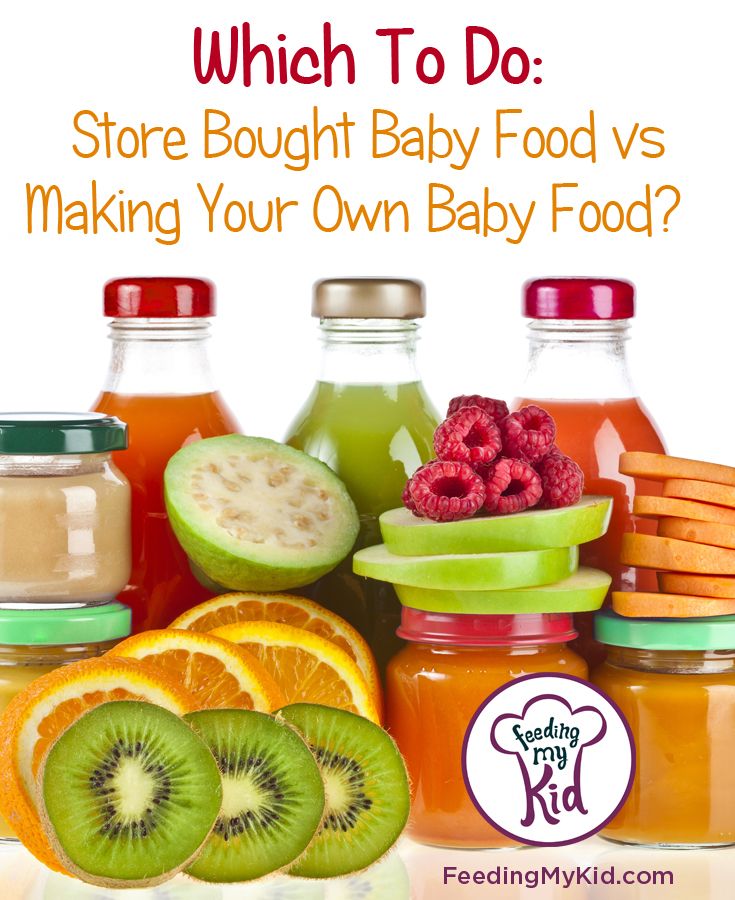 The strictest option does not involve the use of any other products - only mashed potatoes, no juices, curds and other products. It is optimal to use only mono-products, which means that, most likely, you will have to limit yourself to mashed potatoes for the smallest ones, because jars for older children already contain mashed potatoes from several components.
The strictest option does not involve the use of any other products - only mashed potatoes, no juices, curds and other products. It is optimal to use only mono-products, which means that, most likely, you will have to limit yourself to mashed potatoes for the smallest ones, because jars for older children already contain mashed potatoes from several components.
It is recommended that you consume no more than 1200 calories daily. Considering that one jar contains up to 100 kcal, you will need quite a lot of such jars for one day. It is quite possible to lose weight on baby food - following a diet for babies can provide a loss of up to 5 kilograms per week.
An easier and simpler option is to substitute baby puree for several meals or use baby food for a quick snack.
IT'S INTERESTING
Gwyneth Paltrow and other stars whose wedding was canceled on the eve of the celebration
Brad Pitt and Gwyneth Paltrow met on the set of the film "Seven", and they began a stormy romance on the set.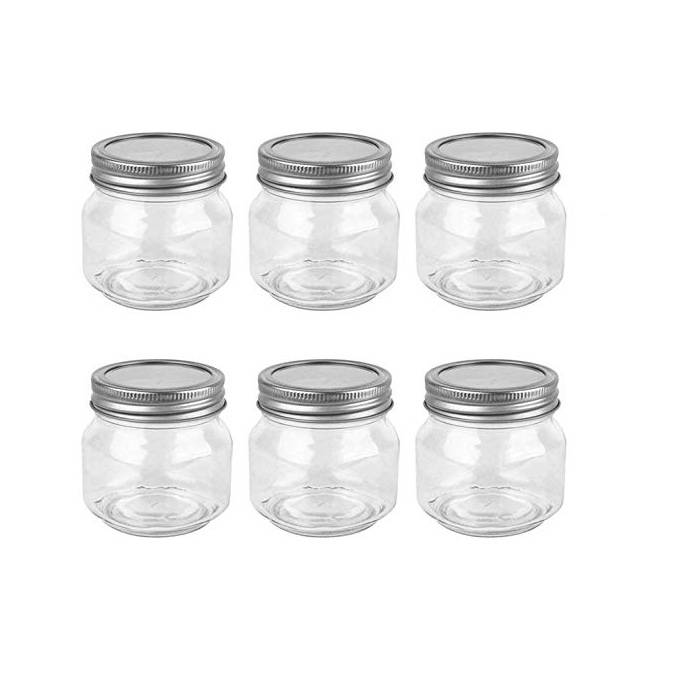 The couple even had the same style of clothing at that time! The upcoming wedding of two sex symbols seemed like the event of the year, but Brad and Gwyneth unexpectedly parted ways. According to rumors, the reason was the bride's infidelity: she allegedly had an affair with colleague John Hannah on the set of "Beware the Doors Are Closing."
The couple even had the same style of clothing at that time! The upcoming wedding of two sex symbols seemed like the event of the year, but Brad and Gwyneth unexpectedly parted ways. According to rumors, the reason was the bride's infidelity: she allegedly had an affair with colleague John Hannah on the set of "Beware the Doors Are Closing."
1 of 5
What are the benefits of a baby food diet?
Such a diet can captivate with its simplicity - you don't need to count calories, because all the data is written on the jar. There is no need to waste time on cooking, serving and studying the composition, and the products for babies are so diverse that such a diet cannot be called boring. Do not forget about the quality of the products - baby food meets the highest standards, and therefore definitely does not contain harmful additives, artificial colors and incomprehensible ingredients.
In general, when choosing food for the little ones, you will definitely not buy pizza for babies or baby fries in a jar: the assortment will be healthy and healthy.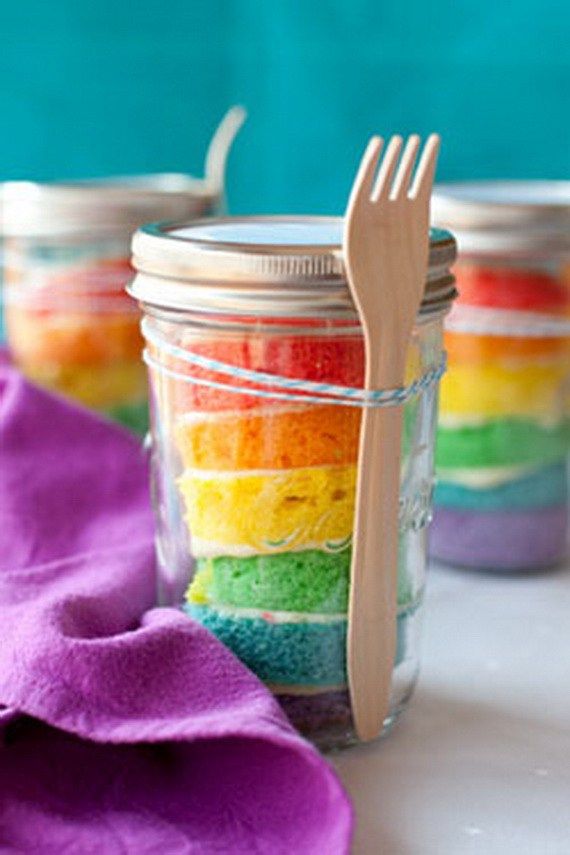 Take at least mashed broccoli or green peas.
Take at least mashed broccoli or green peas.
Weight loss on such a diet is more than real: the absence of harmful products, calorie restriction, portions adjusted to the gram will help get rid of extra pounds.
The Baby Puree Diet: Cons of the Diet
Obviously, for most of us, baby food as a permanent diet will not work - this system can serve to unload for a week or two. Abuse of a strict version of the diet can harm rather than improve the body.
If you follow such a diet, you will have to eat food without spices - salt, pepper and other seasonings are not added to monocomponent purees. Surviving more than two weeks on unleavened food is not so easy.
In addition, it is worth remembering that protein, whole grains, fiber and proper fats enriched with polyunsaturated fatty acids are not enough in children's products - they are quite enough to provide everything a baby needs, but they are not enough for an adult. Long-term adherence to such a diet can lead to digestive problems.
Long-term adherence to such a diet can lead to digestive problems.
For those who have already encountered certain diseases of the digestive system, it is completely worth refusing to use baby puree in large quantities. Also, the diet is not recommended for pregnant and lactating women, those who suffer from anemia, have problems with pressure.
Another important factor is the high cost. A two-week sitting on baby puree will cost a pretty penny, because you will have to eat the contents of 10-15 cans every day, which will cause both the body and the wallet to lose weight at the same time. We also note the environmental aspect - such a huge number of empty jars will quickly accumulate in your house that the question of their proper disposal may arise.
Baby puree: yes or no
Feedback from those who have already tried the baby puree diet is mixed. Some say that such a diet really allowed them to throw off those extra pounds, while others note a constant feeling of hunger for one or two weeks of “canned” nutrition. Many simply yearned for "adult" food, wanting to chew on pieces of food and not only absorb certain foods, but enjoy the very process of eating.
Many simply yearned for "adult" food, wanting to chew on pieces of food and not only absorb certain foods, but enjoy the very process of eating.
Those who nevertheless decide to try such a diet should not forget that it is not necessary to follow it for more than two weeks. It is important to drink enough water, and if necessary, add at least a little fiber to your diet. If any health problems associated with such nutrition occur, the diet should be stopped immediately, and it is best to consult a nutritionist before starting a weight loss course.
Baby food - from a jar or do-it-yourself? Pros and cons
Complementary foods are solid foods for young children in addition to dairy products that they have received for several months as their sole source of nutrition.
— Polina Aleksandrovna, why is the introduction of complementary foods called a transitional stage in a child's nutrition?
— The beginning of acquaintance with complementary foods does not mean the transition to an adult table. The first or second complementary foods are important so that the child adapts and is psychologically ready to eat adult food, and his digestive organs are tuned to work properly. Therefore, complementary foods are considered a transitional stage from milk nutrition to nutrition at a common table.
The first or second complementary foods are important so that the child adapts and is psychologically ready to eat adult food, and his digestive organs are tuned to work properly. Therefore, complementary foods are considered a transitional stage from milk nutrition to nutrition at a common table.
- Does the composition of the canned zucchini or apple puree for babies differ from the homemade version?
- Factory nutrition may vary depending on the raw materials that the manufacturer uses in a particular puree. Therefore, it is impossible to say that all such food is the same. For example, zucchini puree may contain rice flour so that its consistency is more correct in the opinion of the manufacturer. Mom decides what to put in, and in the same way she can add rice flour. An industrial puree that is suitable for a child and meets the requirements of parents may be identical in composition to homemade puree.
— There is a lot of speculation about baby food in jars. What are the most common parenting misconceptions?
What are the most common parenting misconceptions?
- The most common myth is "canned mashed potatoes don't taste good and kids don't eat them well." In fact, most babies enjoy eating factory-made purees without experiencing any problems.
There are concerns that baby puree is “wrong” or does not meet nutritional requirements. The manufacturer is required by law to list all the ingredients of the product. For example, mashed potatoes may contain rice flour that is not always healthy, especially if vegetables are introduced to the child in order to avoid constipation. What kind of food is more useful for the baby, whether to buy just such a puree or look for another in composition - the parents decide together with the doctor. Therefore, it is wrong to equate all manufacturers and their products.
See also
- "10 myths about canned baby food"
- Puree is often said to contain preservatives.
— Modern technologies make it possible not to use preservatives in the production of baby food. That is why it is written on the jars that open food is not stored for more than a day even in the refrigerator. As long as puree does not come into contact with air, it does not spoil within the specified shelf life due to sterilization and vacuum packaging. After opening the jar and contact with air, the puree quickly deteriorates, which indicates the absence of preservatives in it.
That is why it is written on the jars that open food is not stored for more than a day even in the refrigerator. As long as puree does not come into contact with air, it does not spoil within the specified shelf life due to sterilization and vacuum packaging. After opening the jar and contact with air, the puree quickly deteriorates, which indicates the absence of preservatives in it.
— Is it true that canned baby food is addictive, and then the child refuses natural products?
- There is no causal relationship here. When a child refuses a fresh apple, the problem is not the canned puree in his diet, but that he is not familiar with food in pieces. The child ate a homogeneous puree for a long time, and then they offer him a large piece of an apple - naturally, he will not cope with it right away. That is why, after the child gets used to a homogeneous puree, puree with soft small pieces is gradually introduced - so that there is no discomfort if the baby does not chew them.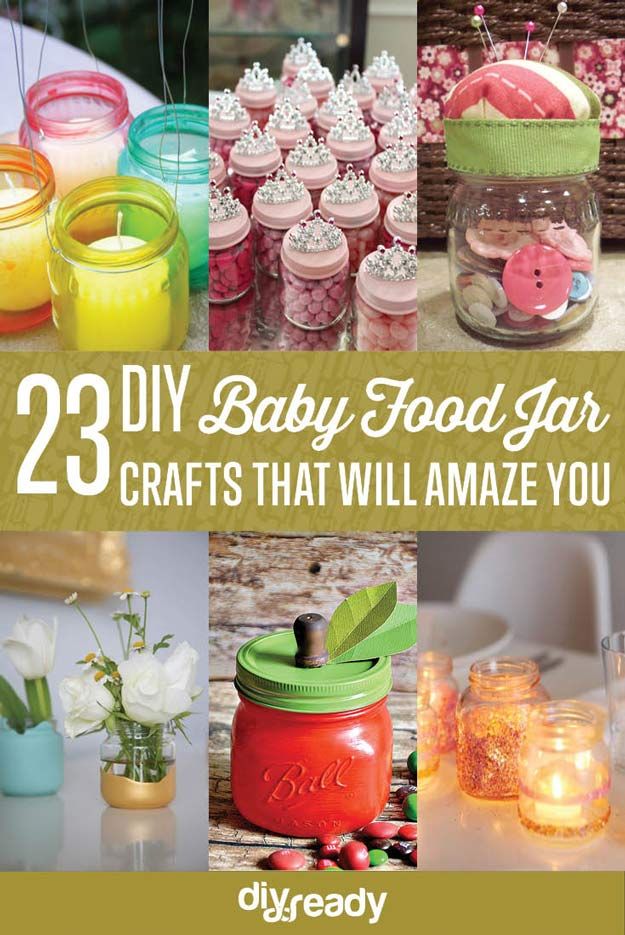 Gradually, the pieces become larger and denser. Over time, the child comes to eat a real whole apple or other hard fruit or vegetable.
Gradually, the pieces become larger and denser. Over time, the child comes to eat a real whole apple or other hard fruit or vegetable.
Baby food in a jar or homemade puree - which is right for a baby? Pros and cons of
— How long can I feed my baby bottled baby food?
- You can feed your baby as much as you like, there is no strict age limit. But baby needs to be introduced to the different textures and flavors of . The need for canned food usually disappears when the baby moves to a common table with a diet familiar to the whole family. During this period, puree from a jar, especially tasty and sweet fruit varieties, often becomes a safe treat for grown-up babies.
— In which cases canned baby puree is contraindicated?
- There are no diseases in which canned puree is contraindicated. But for some diseases, the presence of a particular product in baby food is undesirable. Factory puree is different in composition.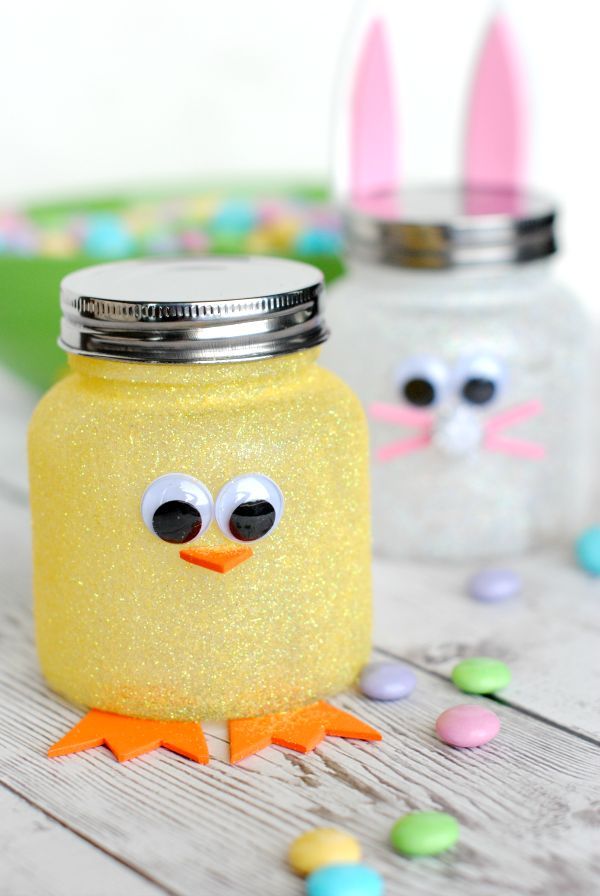 Parents can choose purees without ingredients that are not suitable for the baby or should be limited in his diet, and continue to feed the canned product without problems.
Parents can choose purees without ingredients that are not suitable for the baby or should be limited in his diet, and continue to feed the canned product without problems.
— How to choose baby food in a jar that is healthy for a child?
- First of all, you need to read the full composition of the product on the back, because some ingredients are not indicated on the front label of the jar. It is important to pay attention to the expiration date of the food, the reputation of the manufacturer. All components of the puree must correspond to the age and condition of the child, his individual characteristics.
For example:
- the first puree must not contain rice flour;
- Strawberry puree should not be given to a four-month-old child;
- cereals are excluded from the diet of children with celiac disease (gluten intolerance);
- An older baby should be offered puree with chunks.
What mistakes do parents make when preparing mashed potatoes for feeding with their own hands
- Sometimes parents cook the wrong way - sometimes they overcook vegetables, and also make the puree too thin or thick.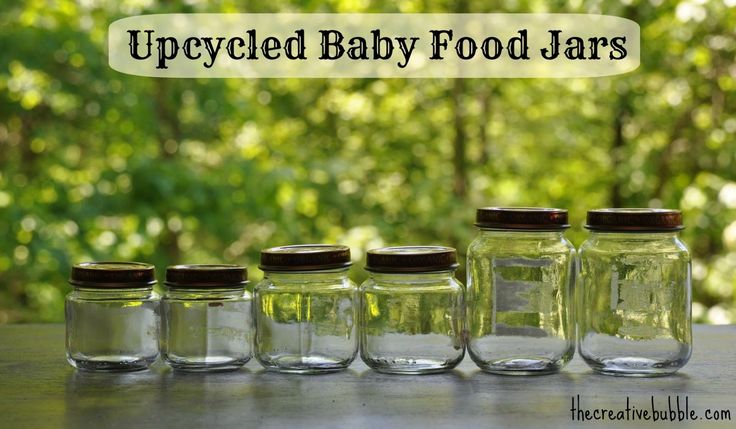 I hope that no one will fry food for their young children instead of boiling or steaming. Sometimes parents put spices and salt in baby puree, which is also not worth doing. The child should initially get acquainted with pure tastes, and extraneous additives are useless.
I hope that no one will fry food for their young children instead of boiling or steaming. Sometimes parents put spices and salt in baby puree, which is also not worth doing. The child should initially get acquainted with pure tastes, and extraneous additives are useless.
In addition, mothers need to be guided by foods that are appropriate for the age of the child, do not cause allergies and are not difficult for him, and also be guided by what the family eats. If parents give the baby something that they themselves do not eat, then when switching to an adult table, he may refuse the usual family food, he will have to cook it separately. This will be a big problem.
- The child refuses the food prepared by the mother and does not eat anything. What to do in such a situation?
— The same food or dish can be offered to the child during the week. Food selectivity in children often depends on taste sensations, but a child may refuse to eat for other reasons, for example, when he is not hungry or would like to play instead of dinner.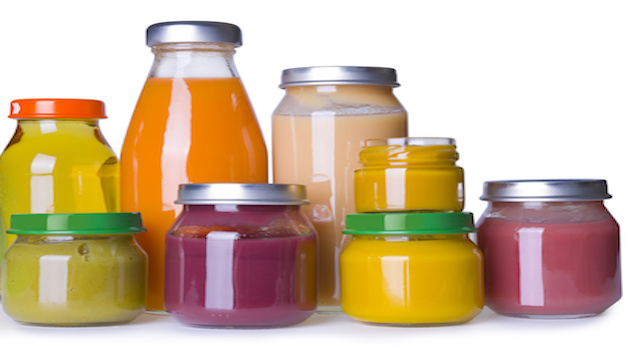 If during the week the child does not perceive the product that the mother offers, perhaps he still does not like it. In this case, the same product can be given in the form of canned food . Often, kids really refuse homemade puree, preferring the factory version. Again, mom can cook another product and give, for example, broccoli instead of zucchini, which the child will appreciate.
If during the week the child does not perceive the product that the mother offers, perhaps he still does not like it. In this case, the same product can be given in the form of canned food . Often, kids really refuse homemade puree, preferring the factory version. Again, mom can cook another product and give, for example, broccoli instead of zucchini, which the child will appreciate.
Fruit baby puree MAMAKO ® contains 20% goat curd. This food option is convenient at the stage of introducing children not only to fruits, but also to dairy products. It is the little ones who eat sweet, tasty foods well during the first feeding period and even when they get older - for dessert.
— Are the recipes for complementary foods from 6 months and the recipes for complementary foods at 10 months different?
- For toddlers, there are no recipes and complex dishes, because it is a simple food for discovering pure tastes without salt and spices, gradually getting used to the texture of the products. In the preparation of the first children's dishes, you can vary the combination of vegetables, focusing on the taste of the baby.
In the preparation of the first children's dishes, you can vary the combination of vegetables, focusing on the taste of the baby.
Recipes appear from the age of two or three with a full transition to the common table, when family preferences become more important. Of course, the baby needs to be introduced to products that are not consumed in the family, because there is a kindergarten and a school ahead. However, the basis of his diet should be food from the common home table . In addition, parents should be careful in cooking: do not overcook foods, do not add artificial ingredients, properly cool food so that homemade vegetable or fruit puree for the first feeding is healthy and safe for the baby.
- Is it possible to combine canned and homemade food and in what proportions?
— There are no strict rules: what is convenient for the family is chosen. For example, it is difficult to make meat puree at home, so sometimes parents add industrial meat supplements to homemade vegetable puree.
There is also no clear gradation in the percentage of different food options. In one plate, you can mix what you have prepared yourself with what you bought in the store. But at home it is not always possible to achieve the desired combinations and prepare, for example, a combined product that includes a variety of fruits and cottage cheese.
Choose a way of eating that is comfortable for your family. It is easier for someone to cook for their child on their own, for someone it is easier to buy ready-made mashed potatoes. Pediatricians often recommend mashed vegetables or fruits of industrial production, because when it is used for a child, the risk of undesirable consequences is much less.
* Breast milk is the best food for babies. WHO recommends exclusive breastfeeding for the first 6 months of a child's life and continued breastfeeding after complementary foods are introduced until the age of 2 years. Before introducing new products into the baby's diet, you should consult with a specialist.




